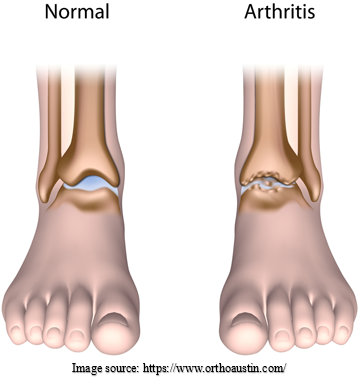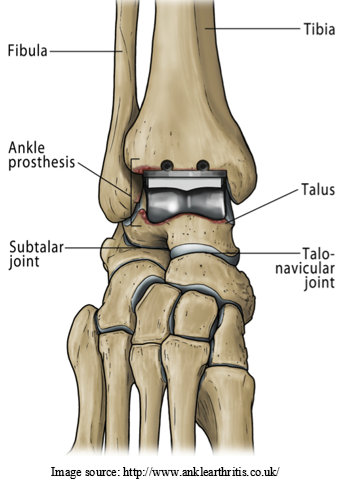Ankle Replacement

Ankle Replacement in Jaipur

The ankle is a complex joint that enables your foot to rotate and pivot with your leg. The tibia, fibula, and talus are the three bones that make up the ankle joint. These bones can easily fit together because cartilage cushions the ends of each one. The cartilage covering this joint may deteriorate due to injury, infection, or wear and tear.
The bone surfaces will rub against one another during movement if the cartilage in the ankle is injured or wears down due to disease or wear and tear. This results in osteoarthritis, causing joint inflammation, pain, and swelling in the ankle. Due to the grinding of the bones against one another, osteoarthritis over time results in bone spurs and joint stiffness.
According to Dr. Dilip Mehta, patients with pain and swelling from ankle arthritis resistant to nonsurgical treatments like ankle braces, physiotherapy, corticosteroid injections, and nonsteroidal anti-inflammatory drugs (NSAIDs) may benefit from ankle replacement in Jaipur.
Dr. Dilip Mehta is one of the best orthopedic surgeon in Jaipur, having years of expertise in complex orthopedic procedures such as joint replacement, ACL reconstruction, sports injury surgery, and so on.
To learn more about the ankle replacement procedure, continue reading this article.
What is Ankle Replacement?
Ankle replacement, also called ankle arthroplasty, is a surgical option for people with ankle arthritis. The arthritic ankle joint can move thanks to this procedure. It is an alternative to arthrodesis, also known as ankle fusion, which can reduce pain but restricts joint movement.
Joint pain is the primary complaint of ankle arthritis patients. Pain is frequently constant and may only be felt in the affected joint. The inflammation around the joint, disease-related joint damage, daily wear and tear of the joint, muscle strains brought on by jarring movements against painful, stiff joints, and exhaustion all contribute to arthritis pain. These issues can be relieved by ankle joint replacement.
Although ankle replacement does not have a long-term record as hip or knee replacement, short-term studies on the procedure seem promising.
Who Is An Ideal Candidate For Ankle Replacement?

- Pain that interferes with daily activities is the primary reason to have surgery. Dr. Dilip Mehta, one of the best orthopedic doctor in Jaipur, suggests surgery if this pain is not managed with bracing or over-the-counter medication.
- If you have severe ankle arthritis, surgery to replace your ankle may be necessary. Walking difficulty may result from symptoms like excruciating pain, inflammation, and stiffness.
- The doctor might suggest alternative therapies for mild or moderate arthritis, such as painkillers, special foot and shoe inserts, physiotherapy, or corticosteroid injections.
- The doctor may advise an ankle replacement procedure or another surgical treatment if your symptoms are still severe and limiting your daily activities.
- An arthroscopic debridement procedure might be preferable if your arthritis is not yet severe. For those with severe ankle arthritis, ankle fusion is another option.
- Each of these options has benefits and risks. Discuss your surgical and therapeutic options with your orthopedic doctor in Jaipur.
How is Ankle Joint Replacement Performed?

- As the ankle replacement is a complicated procedure, you should get it done only by a highly qualified and experienced orthopedic surgeon in Jaipur, such as Dr. Dilip Mehta.
- The anesthesiologist, nurses, and other medical professionals collaborate with the orthopedic surgeon during the ankle replacement surgery.
- First, the anesthesiologist will give a nerve block or general anesthesia.
- After some time, the surgeon will make an incision outside your ankle.
- Next, the surgeon will take out the worn-down (degenerated) cartilage and bone.
- To accommodate the new prosthetics, the surgeon will prepare the joint surface.
- After inserting the pieces, the surgeon will check the joint's mobility. The surgeon may perform other procedures to ensure proper ankle and foot alignment.
Benefits of Ankle Replacement
- You can regain stability and strength in your ankle with an ankle replacement.
- Additionally, this procedure maintains the ankle’s range of motion.
- The replacement parts can articulate or move together like your natural joint.
- You may be able to walk normally, with less pain, and resume an active lifestyle thanks to this flexibility.
Risks of Ankle Replacement
Most of these surgical procedures are completed without any risks.
However, risks can include but are not limited to:
- infection
- damage to the blood vessels or nerves
- bone fracture
- bone fails to heal together
- failure of the bone to heal to the ankle replacement
- wound issues
- blood clotting
Why Choose Us for Ankle Replacement in Jaipur?
- Ankle replacement is an infrequent procedure only carried out by a few skilled orthopedic surgeons in Jaipur.
- Dr. Dilip Mehta has immense experience with joint replacement procedures. Initially, he examines the patient’s foot and ankle.
- Further, Dr. Dilip Mehta devises a plan to treat the particular form of arthritis that affects your ankle and any deformity or misalignment that may affect your ankle and foot.
- After the surgery, he collaborates with the physiotherapist to ensure you get the best results possible with the straightforward objective of getting you back to the things you enjoy doing.
